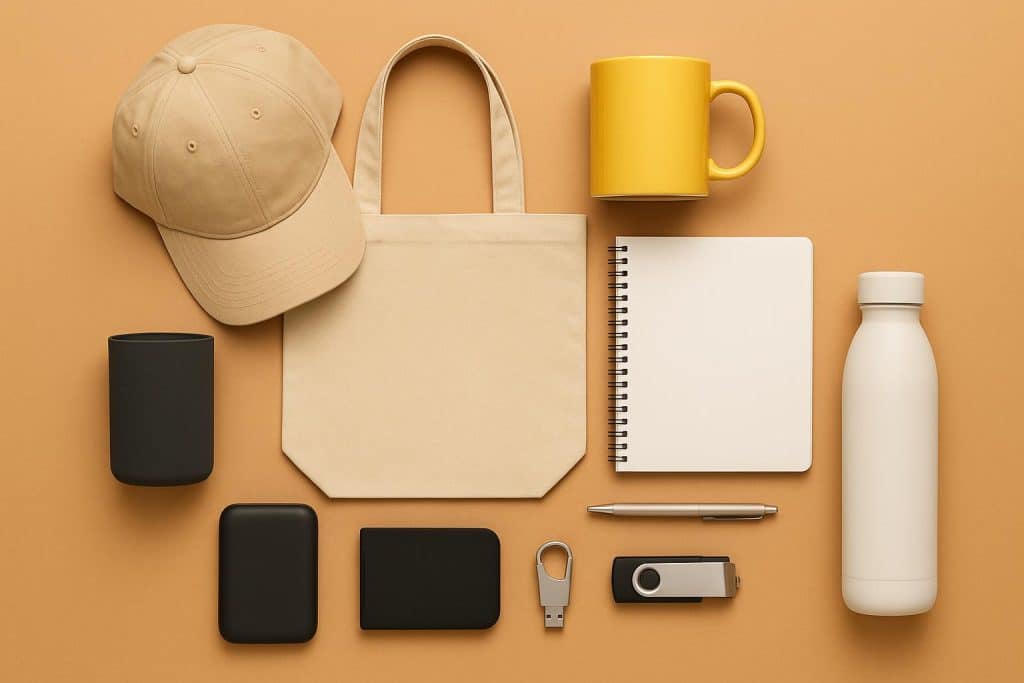Promotional items often outlast the campaigns that introduce them. A mug resting on a desk, a tote slung over a shoulder, or a charger pulled from a bag carries more than utility—it carries a memory of the brand that placed it there. Unlike digital ads, which disappear with a swipe, physical products stay present, tying recognition to everyday habits in subtle, lasting ways.
Marketers face the challenge of balance. Some items build steady familiarity through months of repeated use, while others make an immediate splash before fading. The best strategies weigh audience routines, campaign timelines, and budget realities. When chosen thoughtfully, staples strengthen recognition while trend-driven picks spark short bursts of visibility, giving brands both reliability and reach.
Reliable Items That Deliver Long-Term Use
Practical promotional products form the backbone of lasting brand visibility. A sturdy canvas tote becomes a daily companion for shopping or commuting, offering broad exposure wherever it travels. Stainless tumblers keep beverages at the right temperature through office hours and weekend trips, their durability keeping logos in circulation far longer than disposable drinkware. Classic writing tools—especially refillable pens—extend presence across homes, offices, and classrooms with effortless repetition.
The appeal of such items lies in their consistency. They merge seamlessly with routines, delivering impressions without drawing forced attention. Choosing durable pieces that integrate into work, travel, and leisure gives brands presence that feels natural, familiar, and lasting across seasons.
Short-Lived Products That Create Quick Impact
Short-run giveaways thrive on immediacy. Sunglasses, stress relievers, or inflatable novelties capture attention in seconds, often becoming part of photos or event buzz. They rarely stay in circulation for long, but their value lies in sparking conversations and amplifying visibility during peak moments. Trend-driven tech items, such as wireless chargers or novelty earbuds, also draw crowds quickly, though they risk losing relevance as standards shift.
The most effective short-lived products work when timing and context align. Pairing a fleeting gadget with a low-cost, practical companion—like a microfiber cloth or cord organizer—extends usefulness and increases the odds of continued brand exposure after the initial excitement fades.
Campaign Design That Blends Both Product Types
Blending novelty with durability gives campaigns both spark and staying power. A kit that combines a vacuum-insulated tumbler with a light-up pen, for example, offers instant appeal alongside daily functionality. When presented as a set, the perceived value rises, making recipients more likely to adopt at least one item into routine use.
Mail campaigns benefit from flat, lightweight items like branded notepads, while in-person events shine with interactive, photo-ready swag. Employee onboarding packs also profit from this dual approach, mixing everyday desk tools with a touch of novelty. Thoughtful combinations help logos gain visibility at the moment of engagement and across weeks that follow.
Matching Items to Campaign Timelines and Budgets
Different campaign lengths call for different investments. A short conference run favors high-volume, low-cost items like silicone wristbands or novelty pens, which maximize reach without straining budgets. Longer programs, however, justify premium pieces that hold space on desks or in travel bags, such as leather portfolios or sleek desk clocks. These items communicate durability and strengthen brand associations over time.
Budget strategy also shapes outcomes. A 60/30/10 allocation—sixty percent durable, thirty percent trendy, ten percent experimental sustainable options—balances reach with innovation. Choosing with duration in mind prevents waste, stretches spending further, and allows brands to cultivate both immediate impact and long-term recognition.
Selecting Based on Recipient Lifestyle and Daily Habits
Lifestyle fit determines if a product becomes part of daily rhythm or ends up forgotten. In office settings, slim organizers, refillable bottles, and desk calendars keep a brand visible where decisions happen. Compact accessories that blend into planning routines gain frequent use without competing for attention.
For mobile audiences, portability matters most. Pocket power banks, reliable cables, and lightweight drinkware slip into bags easily, resurfacing wherever work or travel takes them. Community groups lean toward practical, shareable items such as reusable totes, picnic-ready utensils, or sturdy water bottles. Aligning choices with these patterns makes a logo appear naturally, reinforcing presence in ways that feel helpful rather than imposed.
Lasting impact comes when branded items act as both tools and reminders. Durable pieces such as tumblers, pens, and tote bags integrate into daily routines, offering steady visibility without forcing attention. Quick-hit novelties bring bursts of energy to events or seasonal pushes, sparking immediate engagement even if their life span is short. The strongest results come from balance—aligning selections with audience habits, campaign timelines, and budget priorities. When durability meets relevance, impressions extend naturally across moments and settings. Each thoughtful pairing builds presence that feels useful, adaptable, and memorable, allowing brands to remain part of everyday experiences long after distribution.
